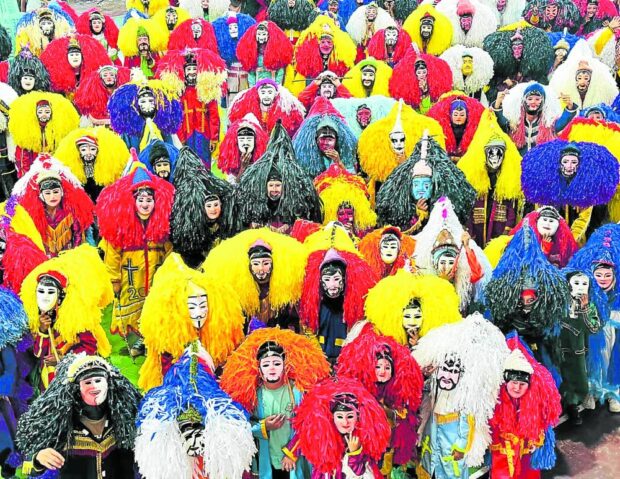
‘ROMAN SOLDIERS’ IN VARYING HUES The parade of “centurions” (Roman foot soldiers) wearing colorful masks and costumes in General Luna, Quezon province, on Holy Monday has attracted tourists to the town. —PHOTO COURTESY OF MAYOR MATT ERWIN FLORIDO
LUCENA CITY, Quezon, Philippines — In General Luna in Quezon province, about 500 residents wearing papier-mâché masks and clad in brightly colored straw and the traditional tunic of the “centurions” paraded through its main thoroughfares beginning on Holy Monday, embodying the reinvention of the town as a new Holy Week destination in the future.
Mayor Matt Erwin Florido said the town decided to give attention this year to its century-old Centurion Festival, which was sidelined in 2019 and further halted after the coronavirus pandemic hit the country, with a parade participated in by local folk of all ages to ensure that the Holy Week tradition lives on.
“Our Lenten tradition is precious to every one of us. We have to preserve it for the next generations,” Florido said in a phone interview on Sunday.
The masked “centurions” later engaged in a “sword fight” at the coast of the town using sticks. The “centurions” roam the streets in the locality during the entire Holy Week.
Local folk, who joined the parade, imitated Roman soldiers wearing the masks and body armor of “centurions,” a unit of Roman foot soldiers associated with the time when Jesus Christ was alive.
Unable to dress like the traditional “morions” (Roman military officers)—who wore centurion masks and body armors—due to the high cost of materials, the “centurions” of General Luna instead used papier-mâché masks crafted from crepe paper and wore colorful clothing, straws and feathers.
Local tradition
The people of General Luna did not know when the Centurion Festival exactly began but Florido said the cultural and religious event had been a part of the Holy Week tradition of his town for more than a century.
“Until now, Marinduque [province] and General Luna have been engaged in a friendly claim on who originally started this Holy Week festival,” Florido said.
Marinduque has its “morions” while General Luna have their own “centurions,” Florido said.
Marinduque’s famous Moriones Festival, believed to have started in 1807 and held on Good Friday, involves male penitents in costumes who parade around Mogpog town of the island-province, which adjoins Quezon.
“But since many parts of the country also have their own centurion festival during Holy Week, we decided when I started as mayor in 2019 to focus on our ‘Buhay na Kubol,’” he explained.
The Buhay na Kubol is the recreation of the 14 Stations of the Cross set up in strategic parts of the locality, with residents in costumes portraying Biblical characters’ roles reenacting the Passion of Christ. The Centurion Festival has now become a component of the Buhay na Kubol program, said Florido.
On Good Friday night, townsfolk and their visitors watched as the municipality staged its first “senakulo,” or the dramatization of the Passion of Christ. The event was held in collaboration with the artists from Quezon’s Sariaya town who have long been staging the traditional senakulo during Holy Week.
Flagellants
On Good Friday, more than 500 of the town’s residents also participated in the parade of flagellants, another long-held tradition of their town like the “centurions,” the mayor said.
“Next year, we will be targeting a Guinness record for having numerous flagellants in one event,” Florido said.
The local government listed the locals who performed the religious ritual of self-flagellation as a form of penance. They roamed the streets in a procession while whipping their backs earlier cut with razor blades. Local authorities require flagellants not to share blades as a health protocol.